Management Accounting Report: Cost Analysis and Reporting Methods
VerifiedAdded on 2020/07/23
|18
|4414
|276
Report
AI Summary
This report delves into the core concepts of management accounting, encompassing the recognition, analysis, recording, and demonstration of financial information for internal stakeholders. It explores the role of management accounting in strategic planning, decision-making, and controlling business activities. The report outlines various methods for management accounting reporting, including budgeting, marginal costing, ratio analysis, and segmented reporting. It evaluates cost analysis techniques to prepare income statements using marginal costing. Furthermore, it examines the advantages and disadvantages of planning tools like budgetary control and compares how enterprises adapt management accounting systems to address financial problems. The report emphasizes the importance of management accounting in providing insights for effective business plans, financial stability, and operational improvements.

Management Accounting
Paraphrase This Document
Need a fresh take? Get an instant paraphrase of this document with our AI Paraphraser
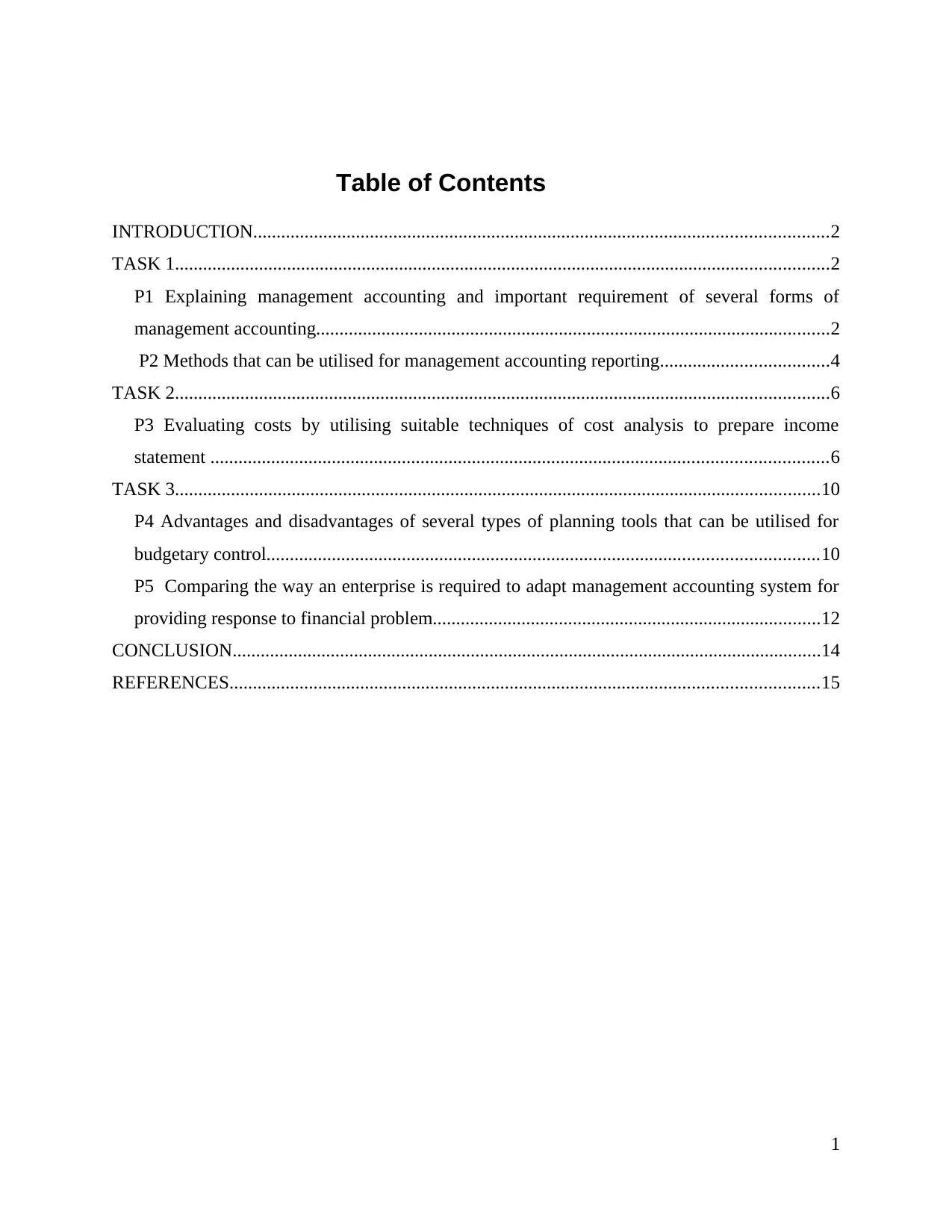
Table of Contents
INTRODUCTION...........................................................................................................................2
TASK 1............................................................................................................................................2
P1 Explaining management accounting and important requirement of several forms of
management accounting..............................................................................................................2
P2 Methods that can be utilised for management accounting reporting....................................4
TASK 2............................................................................................................................................6
P3 Evaluating costs by utilising suitable techniques of cost analysis to prepare income
statement ....................................................................................................................................6
TASK 3..........................................................................................................................................10
P4 Advantages and disadvantages of several types of planning tools that can be utilised for
budgetary control......................................................................................................................10
P5 Comparing the way an enterprise is required to adapt management accounting system for
providing response to financial problem...................................................................................12
CONCLUSION..............................................................................................................................14
REFERENCES..............................................................................................................................15
1
INTRODUCTION...........................................................................................................................2
TASK 1............................................................................................................................................2
P1 Explaining management accounting and important requirement of several forms of
management accounting..............................................................................................................2
P2 Methods that can be utilised for management accounting reporting....................................4
TASK 2............................................................................................................................................6
P3 Evaluating costs by utilising suitable techniques of cost analysis to prepare income
statement ....................................................................................................................................6
TASK 3..........................................................................................................................................10
P4 Advantages and disadvantages of several types of planning tools that can be utilised for
budgetary control......................................................................................................................10
P5 Comparing the way an enterprise is required to adapt management accounting system for
providing response to financial problem...................................................................................12
CONCLUSION..............................................................................................................................14
REFERENCES..............................................................................................................................15
1
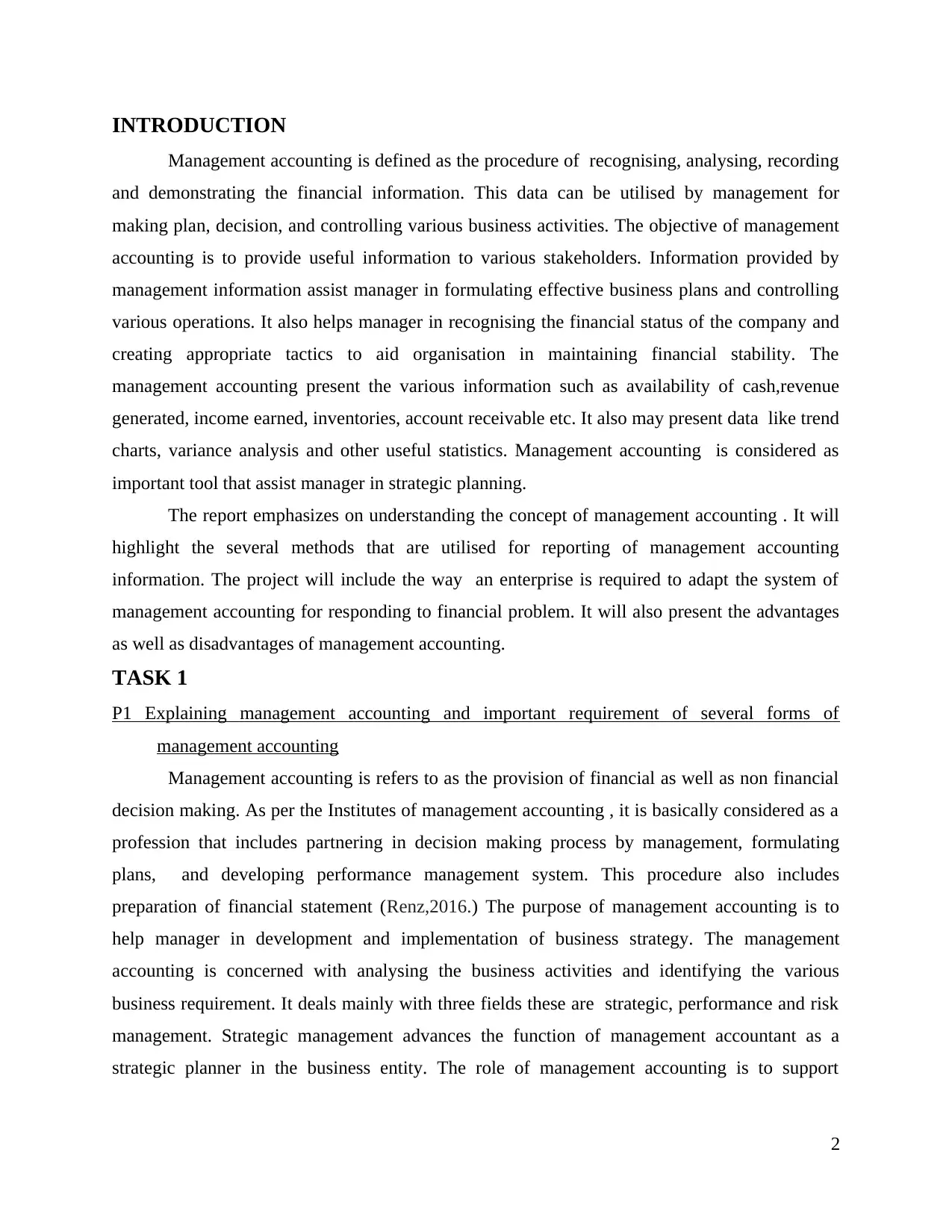
INTRODUCTION
Management accounting is defined as the procedure of recognising, analysing, recording
and demonstrating the financial information. This data can be utilised by management for
making plan, decision, and controlling various business activities. The objective of management
accounting is to provide useful information to various stakeholders. Information provided by
management information assist manager in formulating effective business plans and controlling
various operations. It also helps manager in recognising the financial status of the company and
creating appropriate tactics to aid organisation in maintaining financial stability. The
management accounting present the various information such as availability of cash,revenue
generated, income earned, inventories, account receivable etc. It also may present data like trend
charts, variance analysis and other useful statistics. Management accounting is considered as
important tool that assist manager in strategic planning.
The report emphasizes on understanding the concept of management accounting . It will
highlight the several methods that are utilised for reporting of management accounting
information. The project will include the way an enterprise is required to adapt the system of
management accounting for responding to financial problem. It will also present the advantages
as well as disadvantages of management accounting.
TASK 1
P1 Explaining management accounting and important requirement of several forms of
management accounting
Management accounting is refers to as the provision of financial as well as non financial
decision making. As per the Institutes of management accounting , it is basically considered as a
profession that includes partnering in decision making process by management, formulating
plans, and developing performance management system. This procedure also includes
preparation of financial statement (Renz,2016.) The purpose of management accounting is to
help manager in development and implementation of business strategy. The management
accounting is concerned with analysing the business activities and identifying the various
business requirement. It deals mainly with three fields these are strategic, performance and risk
management. Strategic management advances the function of management accountant as a
strategic planner in the business entity. The role of management accounting is to support
2
Management accounting is defined as the procedure of recognising, analysing, recording
and demonstrating the financial information. This data can be utilised by management for
making plan, decision, and controlling various business activities. The objective of management
accounting is to provide useful information to various stakeholders. Information provided by
management information assist manager in formulating effective business plans and controlling
various operations. It also helps manager in recognising the financial status of the company and
creating appropriate tactics to aid organisation in maintaining financial stability. The
management accounting present the various information such as availability of cash,revenue
generated, income earned, inventories, account receivable etc. It also may present data like trend
charts, variance analysis and other useful statistics. Management accounting is considered as
important tool that assist manager in strategic planning.
The report emphasizes on understanding the concept of management accounting . It will
highlight the several methods that are utilised for reporting of management accounting
information. The project will include the way an enterprise is required to adapt the system of
management accounting for responding to financial problem. It will also present the advantages
as well as disadvantages of management accounting.
TASK 1
P1 Explaining management accounting and important requirement of several forms of
management accounting
Management accounting is refers to as the provision of financial as well as non financial
decision making. As per the Institutes of management accounting , it is basically considered as a
profession that includes partnering in decision making process by management, formulating
plans, and developing performance management system. This procedure also includes
preparation of financial statement (Renz,2016.) The purpose of management accounting is to
help manager in development and implementation of business strategy. The management
accounting is concerned with analysing the business activities and identifying the various
business requirement. It deals mainly with three fields these are strategic, performance and risk
management. Strategic management advances the function of management accountant as a
strategic planner in the business entity. The role of management accounting is to support
2
⊘ This is a preview!⊘
Do you want full access?
Subscribe today to unlock all pages.

Trusted by 1+ million students worldwide

manager in designing the business practice, assist in making suitable decision. It also aids
organisation in managing as well as improving business performance. Management accounting
contributes to guidelines and practices for recognising, evaluating, managing and reporting risks
in order to achieve goals and objectives for the enterprise (Owusu,2016) The preparation of
management accounting require specialise knowledge and skills in order to develop and present
financial or other decision oriented data or other useful information. Management accounting
helps management team in development of business policies , planning and controlling
organisational activities. It is considered as value creator as it has focus on planning and making
decisions for the future of an enterprise. The professional knowledge and related to management
accounting and experience can be gained from several areas and function within a company like
treasury, information management system, auditing. Valuation, pricing, logistics and marketing.
The number of tools that can be adopted by manager for effective as well as suitable decision
making. These methods are budget , forecasts and analysis etc. (Suomala, Lyly-Yrjänäinen and
Lukka,2014.) The management accounting provides a detail data about goods, employees
activities, operational, various projects, divisional plants and operations. The objective of
utilising management accounting system is to identify the additional expenses and planning
strategies to reduce costs. It also aids business entity in recognising the overheads that has great
impact on the overall profit and growth of organisation. Management accounting assist manager
in Answer lab company in analysing its existing business profits and losses. It also supports cited
venture in predicting the benefits that can be gained in the future by an enterprise. Management
accounting system helps manager in identifying the current business performance and
formulating strategies in order to enhance the operations. It also supports management in
establishing bench marks for measuring the actual business performance with standard.
Management accounting system enables firm in ensuring the effective as well as efficient
utilisation of business financial resources. It aids business entity in controlling the cash flow and
reducing various costs. Hence, it is proved that management accounting plays significant role in
identifying the need of resources and assist account manager in making suitable as well as
effective decision. Management accounting is also recognised as cost control device that enables
organisation to reduce the prices of products. It also allows business entity to provide good
quality products at reasonable price to customers.
3
organisation in managing as well as improving business performance. Management accounting
contributes to guidelines and practices for recognising, evaluating, managing and reporting risks
in order to achieve goals and objectives for the enterprise (Owusu,2016) The preparation of
management accounting require specialise knowledge and skills in order to develop and present
financial or other decision oriented data or other useful information. Management accounting
helps management team in development of business policies , planning and controlling
organisational activities. It is considered as value creator as it has focus on planning and making
decisions for the future of an enterprise. The professional knowledge and related to management
accounting and experience can be gained from several areas and function within a company like
treasury, information management system, auditing. Valuation, pricing, logistics and marketing.
The number of tools that can be adopted by manager for effective as well as suitable decision
making. These methods are budget , forecasts and analysis etc. (Suomala, Lyly-Yrjänäinen and
Lukka,2014.) The management accounting provides a detail data about goods, employees
activities, operational, various projects, divisional plants and operations. The objective of
utilising management accounting system is to identify the additional expenses and planning
strategies to reduce costs. It also aids business entity in recognising the overheads that has great
impact on the overall profit and growth of organisation. Management accounting assist manager
in Answer lab company in analysing its existing business profits and losses. It also supports cited
venture in predicting the benefits that can be gained in the future by an enterprise. Management
accounting system helps manager in identifying the current business performance and
formulating strategies in order to enhance the operations. It also supports management in
establishing bench marks for measuring the actual business performance with standard.
Management accounting system enables firm in ensuring the effective as well as efficient
utilisation of business financial resources. It aids business entity in controlling the cash flow and
reducing various costs. Hence, it is proved that management accounting plays significant role in
identifying the need of resources and assist account manager in making suitable as well as
effective decision. Management accounting is also recognised as cost control device that enables
organisation to reduce the prices of products. It also allows business entity to provide good
quality products at reasonable price to customers.
3
Paraphrase This Document
Need a fresh take? Get an instant paraphrase of this document with our AI Paraphraser
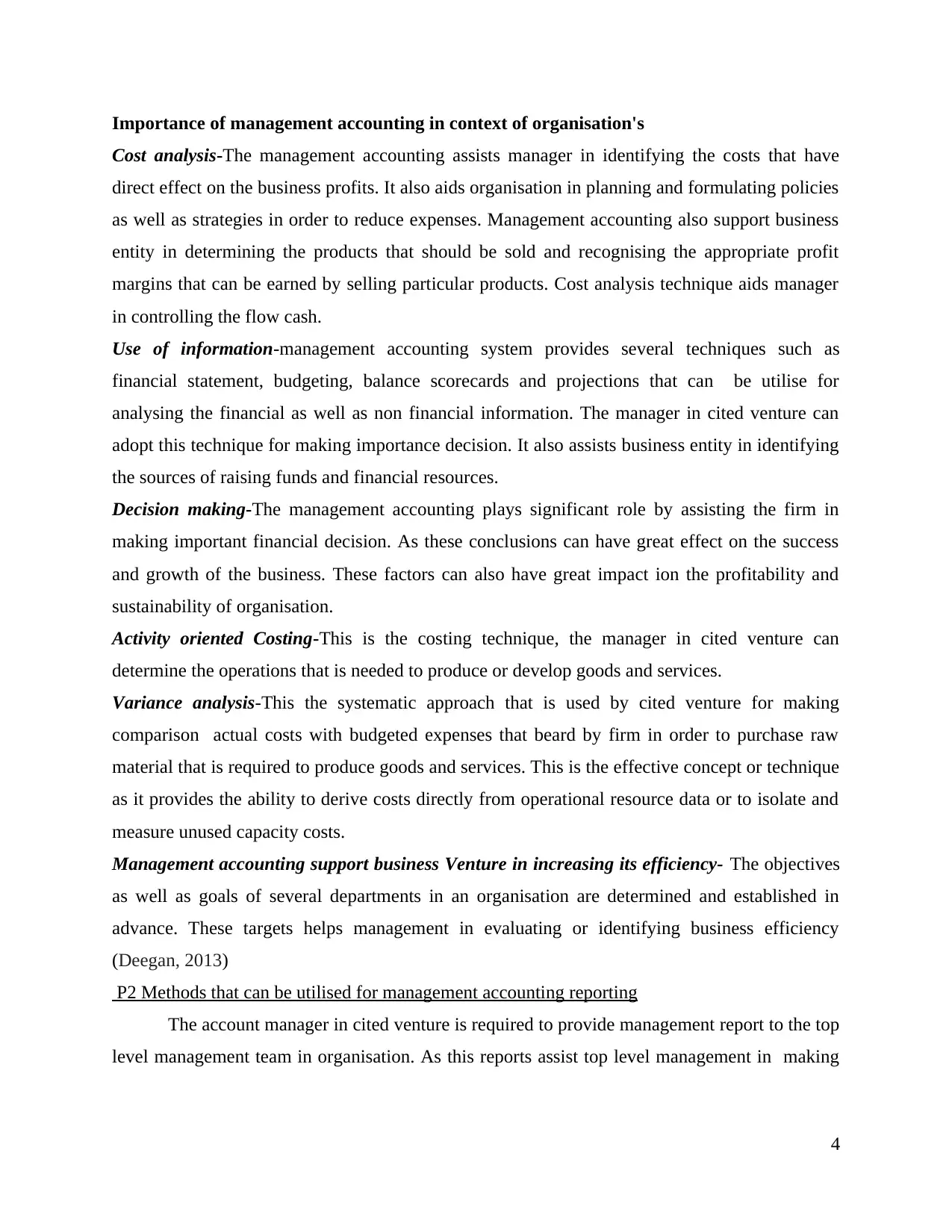
Importance of management accounting in context of organisation's
Cost analysis-The management accounting assists manager in identifying the costs that have
direct effect on the business profits. It also aids organisation in planning and formulating policies
as well as strategies in order to reduce expenses. Management accounting also support business
entity in determining the products that should be sold and recognising the appropriate profit
margins that can be earned by selling particular products. Cost analysis technique aids manager
in controlling the flow cash.
Use of information-management accounting system provides several techniques such as
financial statement, budgeting, balance scorecards and projections that can be utilise for
analysing the financial as well as non financial information. The manager in cited venture can
adopt this technique for making importance decision. It also assists business entity in identifying
the sources of raising funds and financial resources.
Decision making-The management accounting plays significant role by assisting the firm in
making important financial decision. As these conclusions can have great effect on the success
and growth of the business. These factors can also have great impact ion the profitability and
sustainability of organisation.
Activity oriented Costing-This is the costing technique, the manager in cited venture can
determine the operations that is needed to produce or develop goods and services.
Variance analysis-This the systematic approach that is used by cited venture for making
comparison actual costs with budgeted expenses that beard by firm in order to purchase raw
material that is required to produce goods and services. This is the effective concept or technique
as it provides the ability to derive costs directly from operational resource data or to isolate and
measure unused capacity costs.
Management accounting support business Venture in increasing its efficiency- The objectives
as well as goals of several departments in an organisation are determined and established in
advance. These targets helps management in evaluating or identifying business efficiency
(Deegan, 2013)
P2 Methods that can be utilised for management accounting reporting
The account manager in cited venture is required to provide management report to the top
level management team in organisation. As this reports assist top level management in making
4
Cost analysis-The management accounting assists manager in identifying the costs that have
direct effect on the business profits. It also aids organisation in planning and formulating policies
as well as strategies in order to reduce expenses. Management accounting also support business
entity in determining the products that should be sold and recognising the appropriate profit
margins that can be earned by selling particular products. Cost analysis technique aids manager
in controlling the flow cash.
Use of information-management accounting system provides several techniques such as
financial statement, budgeting, balance scorecards and projections that can be utilise for
analysing the financial as well as non financial information. The manager in cited venture can
adopt this technique for making importance decision. It also assists business entity in identifying
the sources of raising funds and financial resources.
Decision making-The management accounting plays significant role by assisting the firm in
making important financial decision. As these conclusions can have great effect on the success
and growth of the business. These factors can also have great impact ion the profitability and
sustainability of organisation.
Activity oriented Costing-This is the costing technique, the manager in cited venture can
determine the operations that is needed to produce or develop goods and services.
Variance analysis-This the systematic approach that is used by cited venture for making
comparison actual costs with budgeted expenses that beard by firm in order to purchase raw
material that is required to produce goods and services. This is the effective concept or technique
as it provides the ability to derive costs directly from operational resource data or to isolate and
measure unused capacity costs.
Management accounting support business Venture in increasing its efficiency- The objectives
as well as goals of several departments in an organisation are determined and established in
advance. These targets helps management in evaluating or identifying business efficiency
(Deegan, 2013)
P2 Methods that can be utilised for management accounting reporting
The account manager in cited venture is required to provide management report to the top
level management team in organisation. As this reports assist top level management in making
4
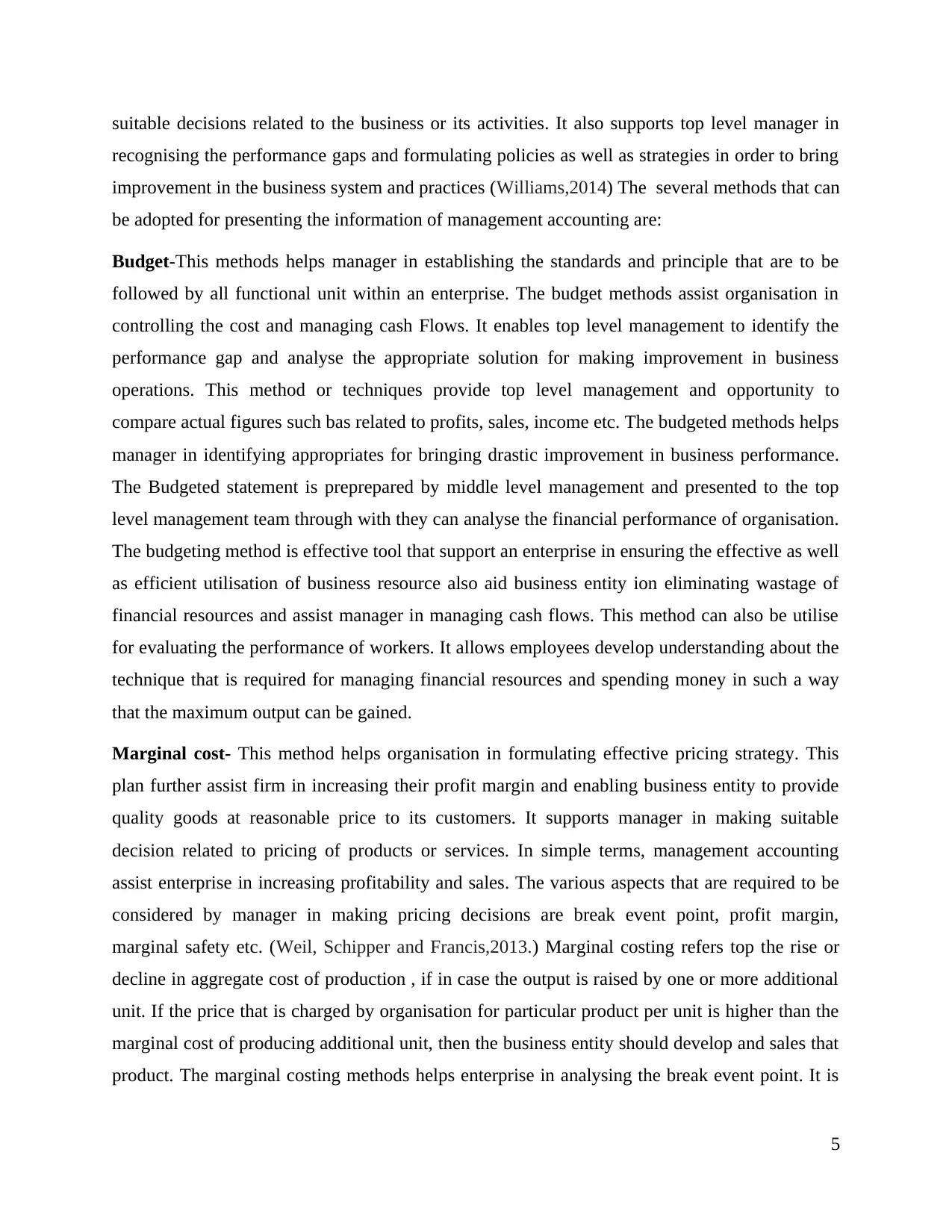
suitable decisions related to the business or its activities. It also supports top level manager in
recognising the performance gaps and formulating policies as well as strategies in order to bring
improvement in the business system and practices (Williams,2014) The several methods that can
be adopted for presenting the information of management accounting are:
Budget-This methods helps manager in establishing the standards and principle that are to be
followed by all functional unit within an enterprise. The budget methods assist organisation in
controlling the cost and managing cash Flows. It enables top level management to identify the
performance gap and analyse the appropriate solution for making improvement in business
operations. This method or techniques provide top level management and opportunity to
compare actual figures such bas related to profits, sales, income etc. The budgeted methods helps
manager in identifying appropriates for bringing drastic improvement in business performance.
The Budgeted statement is preprepared by middle level management and presented to the top
level management team through with they can analyse the financial performance of organisation.
The budgeting method is effective tool that support an enterprise in ensuring the effective as well
as efficient utilisation of business resource also aid business entity ion eliminating wastage of
financial resources and assist manager in managing cash flows. This method can also be utilise
for evaluating the performance of workers. It allows employees develop understanding about the
technique that is required for managing financial resources and spending money in such a way
that the maximum output can be gained.
Marginal cost- This method helps organisation in formulating effective pricing strategy. This
plan further assist firm in increasing their profit margin and enabling business entity to provide
quality goods at reasonable price to its customers. It supports manager in making suitable
decision related to pricing of products or services. In simple terms, management accounting
assist enterprise in increasing profitability and sales. The various aspects that are required to be
considered by manager in making pricing decisions are break event point, profit margin,
marginal safety etc. (Weil, Schipper and Francis,2013.) Marginal costing refers top the rise or
decline in aggregate cost of production , if in case the output is raised by one or more additional
unit. If the price that is charged by organisation for particular product per unit is higher than the
marginal cost of producing additional unit, then the business entity should develop and sales that
product. The marginal costing methods helps enterprise in analysing the break event point. It is
5
recognising the performance gaps and formulating policies as well as strategies in order to bring
improvement in the business system and practices (Williams,2014) The several methods that can
be adopted for presenting the information of management accounting are:
Budget-This methods helps manager in establishing the standards and principle that are to be
followed by all functional unit within an enterprise. The budget methods assist organisation in
controlling the cost and managing cash Flows. It enables top level management to identify the
performance gap and analyse the appropriate solution for making improvement in business
operations. This method or techniques provide top level management and opportunity to
compare actual figures such bas related to profits, sales, income etc. The budgeted methods helps
manager in identifying appropriates for bringing drastic improvement in business performance.
The Budgeted statement is preprepared by middle level management and presented to the top
level management team through with they can analyse the financial performance of organisation.
The budgeting method is effective tool that support an enterprise in ensuring the effective as well
as efficient utilisation of business resource also aid business entity ion eliminating wastage of
financial resources and assist manager in managing cash flows. This method can also be utilise
for evaluating the performance of workers. It allows employees develop understanding about the
technique that is required for managing financial resources and spending money in such a way
that the maximum output can be gained.
Marginal cost- This method helps organisation in formulating effective pricing strategy. This
plan further assist firm in increasing their profit margin and enabling business entity to provide
quality goods at reasonable price to its customers. It supports manager in making suitable
decision related to pricing of products or services. In simple terms, management accounting
assist enterprise in increasing profitability and sales. The various aspects that are required to be
considered by manager in making pricing decisions are break event point, profit margin,
marginal safety etc. (Weil, Schipper and Francis,2013.) Marginal costing refers top the rise or
decline in aggregate cost of production , if in case the output is raised by one or more additional
unit. If the price that is charged by organisation for particular product per unit is higher than the
marginal cost of producing additional unit, then the business entity should develop and sales that
product. The marginal costing methods helps enterprise in analysing the break event point. It is
5
⊘ This is a preview!⊘
Do you want full access?
Subscribe today to unlock all pages.

Trusted by 1+ million students worldwide

the point in which the firm incur no loss or no profits .Break even analysis support business
entity in identifying the unit which it requires producing or sell for attaining the situation of no
profit and no loss. This is the point at which the cited venture can recover the cost or additional
expenses .In simple words it can be stated that marginal costing methods can be adopted by cited
venture for determining the expenses which the enterprise has to bear in manufacturing or
producing additional unit of product.
Ratio analysis-This is the other method or system of management accounting that can be
adopted by organisation for measuring the financial as well as overall business performance. It
assists firm in increasing efficiency, profitability, solvency and liquidity. Ratio analysis indicates
the financial performance of enterprise. Ratio analysis is considered as the procedure that assist
manager in determining and explaining the relationship that are based on financial statement.
This method assist enterprise in predicting, coordinating various business operations. It also
supports stakeholders such as investors in obtaining the clear information about the financial
stability and analysing the profitability status of the firm. Liquidity ratio helps manager in
recognising the amount of business funds and determining the additional financial resources
required to fulfil the current liabilities. It also supports cited venture in identifying the effective
sources through which the funds can be raised. Ratio analysis assist manager in determining the
need and importance of changes in the policies, procedures and system. This activity will allow
business entity in improving business performance and assist enterprise in maintaining financial
stability.
Segmented report- This statement is prepared by accountant in order to share organisation
financial information with public. It supports creditors and investors to obtain all financial
information about the company (Ionescu, 2014.)
TASK 2
P3 Evaluating costs by utilising suitable techniques of cost analysis to prepare income statement
Net profit calculation through marginal costing method
Marginal costing is also recognised as incremental costing. This costing method is
adopted by cited venture for selecting the product and choosing the procedure to conduct. This
activity is facilitated to in for identifying the product or procedure that yield maximum output or
6
entity in identifying the unit which it requires producing or sell for attaining the situation of no
profit and no loss. This is the point at which the cited venture can recover the cost or additional
expenses .In simple words it can be stated that marginal costing methods can be adopted by cited
venture for determining the expenses which the enterprise has to bear in manufacturing or
producing additional unit of product.
Ratio analysis-This is the other method or system of management accounting that can be
adopted by organisation for measuring the financial as well as overall business performance. It
assists firm in increasing efficiency, profitability, solvency and liquidity. Ratio analysis indicates
the financial performance of enterprise. Ratio analysis is considered as the procedure that assist
manager in determining and explaining the relationship that are based on financial statement.
This method assist enterprise in predicting, coordinating various business operations. It also
supports stakeholders such as investors in obtaining the clear information about the financial
stability and analysing the profitability status of the firm. Liquidity ratio helps manager in
recognising the amount of business funds and determining the additional financial resources
required to fulfil the current liabilities. It also supports cited venture in identifying the effective
sources through which the funds can be raised. Ratio analysis assist manager in determining the
need and importance of changes in the policies, procedures and system. This activity will allow
business entity in improving business performance and assist enterprise in maintaining financial
stability.
Segmented report- This statement is prepared by accountant in order to share organisation
financial information with public. It supports creditors and investors to obtain all financial
information about the company (Ionescu, 2014.)
TASK 2
P3 Evaluating costs by utilising suitable techniques of cost analysis to prepare income statement
Net profit calculation through marginal costing method
Marginal costing is also recognised as incremental costing. This costing method is
adopted by cited venture for selecting the product and choosing the procedure to conduct. This
activity is facilitated to in for identifying the product or procedure that yield maximum output or
6
Paraphrase This Document
Need a fresh take? Get an instant paraphrase of this document with our AI Paraphraser
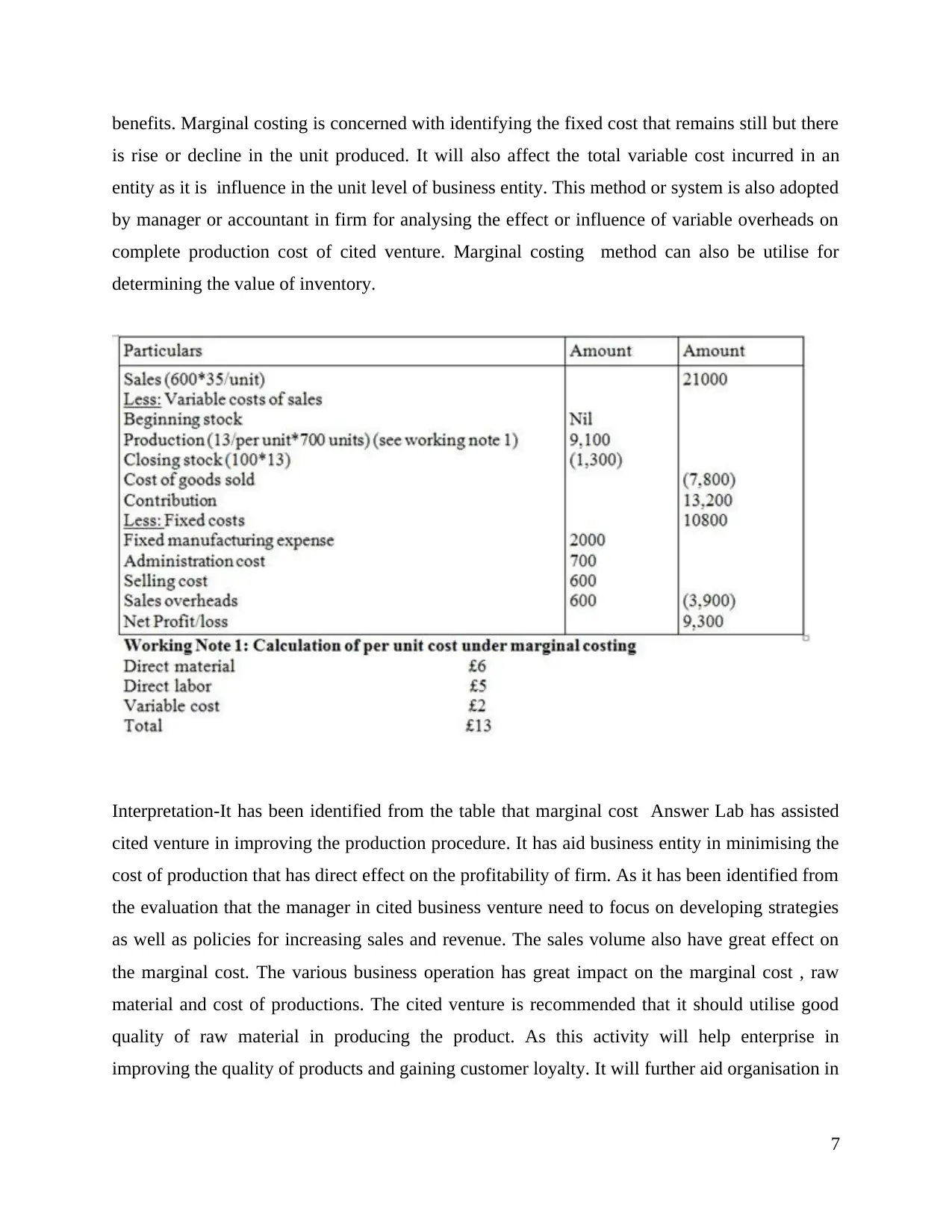
benefits. Marginal costing is concerned with identifying the fixed cost that remains still but there
is rise or decline in the unit produced. It will also affect the total variable cost incurred in an
entity as it is influence in the unit level of business entity. This method or system is also adopted
by manager or accountant in firm for analysing the effect or influence of variable overheads on
complete production cost of cited venture. Marginal costing method can also be utilise for
determining the value of inventory.
Interpretation-It has been identified from the table that marginal cost Answer Lab has assisted
cited venture in improving the production procedure. It has aid business entity in minimising the
cost of production that has direct effect on the profitability of firm. As it has been identified from
the evaluation that the manager in cited business venture need to focus on developing strategies
as well as policies for increasing sales and revenue. The sales volume also have great effect on
the marginal cost. The various business operation has great impact on the marginal cost , raw
material and cost of productions. The cited venture is recommended that it should utilise good
quality of raw material in producing the product. As this activity will help enterprise in
improving the quality of products and gaining customer loyalty. It will further aid organisation in
7
is rise or decline in the unit produced. It will also affect the total variable cost incurred in an
entity as it is influence in the unit level of business entity. This method or system is also adopted
by manager or accountant in firm for analysing the effect or influence of variable overheads on
complete production cost of cited venture. Marginal costing method can also be utilise for
determining the value of inventory.
Interpretation-It has been identified from the table that marginal cost Answer Lab has assisted
cited venture in improving the production procedure. It has aid business entity in minimising the
cost of production that has direct effect on the profitability of firm. As it has been identified from
the evaluation that the manager in cited business venture need to focus on developing strategies
as well as policies for increasing sales and revenue. The sales volume also have great effect on
the marginal cost. The various business operation has great impact on the marginal cost , raw
material and cost of productions. The cited venture is recommended that it should utilise good
quality of raw material in producing the product. As this activity will help enterprise in
improving the quality of products and gaining customer loyalty. It will further aid organisation in
7

increasing its sales and profitability. Innovation is another strategy that will provides enterprise
an opportunity to attract more customers. The utilisation of better quality of raw material in the
production procedure assists enterprise in saving cost. It also aids business entity in minimising
the wastage of resources and reduction of short term losses.
Income statement by absorption costing methods
Absorption costing technique-It is defined as a method of evaluating the cost of goods by
considering the indirect expenses as well as direct costs. Absorption costing technique is also
considered as managerial accounting cost method that can be used for determining all the
expenses or cost that are related to manufacturing of specific product. Absorption costing refers
to the manufacturing expenses that are absorbed by the unit of particular item produced. The
cost of completed unit of product that are kept as inventory involves direct labour, material, fixed
as well as variables manufacturing expenses.
In absorption costing method all the operations as well as evaluation are conducted on the
basis of manufacturing procedure.
8
an opportunity to attract more customers. The utilisation of better quality of raw material in the
production procedure assists enterprise in saving cost. It also aids business entity in minimising
the wastage of resources and reduction of short term losses.
Income statement by absorption costing methods
Absorption costing technique-It is defined as a method of evaluating the cost of goods by
considering the indirect expenses as well as direct costs. Absorption costing technique is also
considered as managerial accounting cost method that can be used for determining all the
expenses or cost that are related to manufacturing of specific product. Absorption costing refers
to the manufacturing expenses that are absorbed by the unit of particular item produced. The
cost of completed unit of product that are kept as inventory involves direct labour, material, fixed
as well as variables manufacturing expenses.
In absorption costing method all the operations as well as evaluation are conducted on the
basis of manufacturing procedure.
8
⊘ This is a preview!⊘
Do you want full access?
Subscribe today to unlock all pages.

Trusted by 1+ million students worldwide
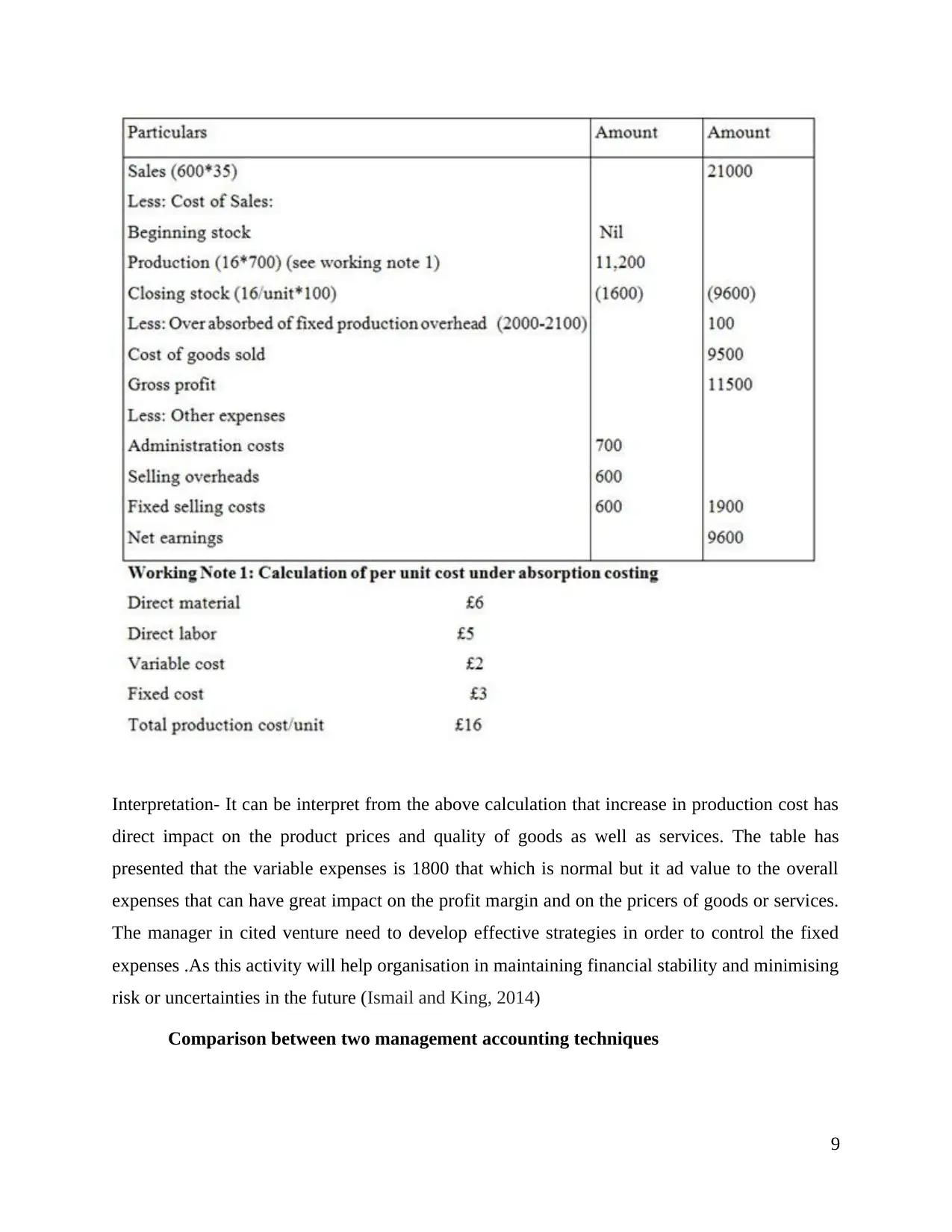
Interpretation- It can be interpret from the above calculation that increase in production cost has
direct impact on the product prices and quality of goods as well as services. The table has
presented that the variable expenses is 1800 that which is normal but it ad value to the overall
expenses that can have great impact on the profit margin and on the pricers of goods or services.
The manager in cited venture need to develop effective strategies in order to control the fixed
expenses .As this activity will help organisation in maintaining financial stability and minimising
risk or uncertainties in the future (Ismail and King, 2014)
Comparison between two management accounting techniques
9
direct impact on the product prices and quality of goods as well as services. The table has
presented that the variable expenses is 1800 that which is normal but it ad value to the overall
expenses that can have great impact on the profit margin and on the pricers of goods or services.
The manager in cited venture need to develop effective strategies in order to control the fixed
expenses .As this activity will help organisation in maintaining financial stability and minimising
risk or uncertainties in the future (Ismail and King, 2014)
Comparison between two management accounting techniques
9
Paraphrase This Document
Need a fresh take? Get an instant paraphrase of this document with our AI Paraphraser
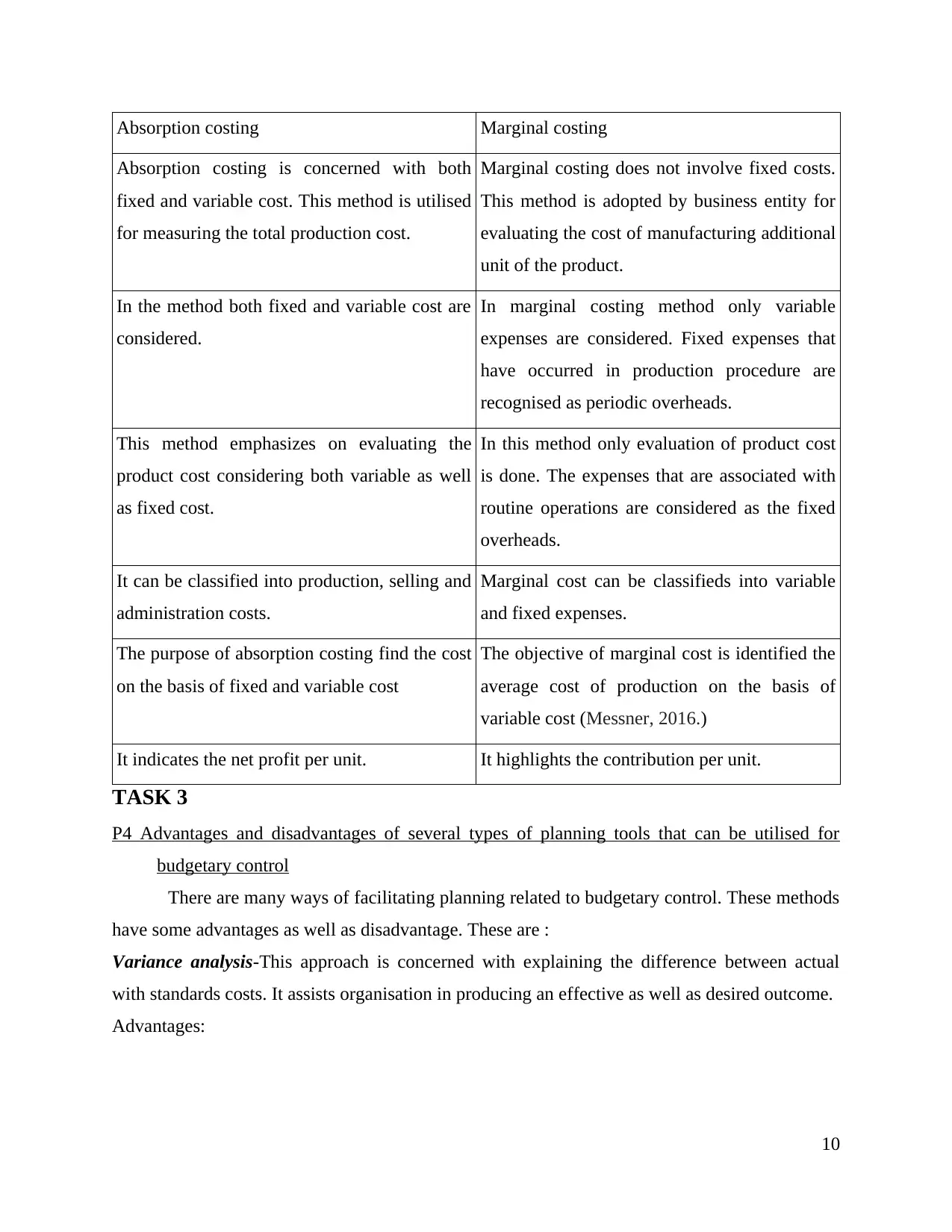
Absorption costing Marginal costing
Absorption costing is concerned with both
fixed and variable cost. This method is utilised
for measuring the total production cost.
Marginal costing does not involve fixed costs.
This method is adopted by business entity for
evaluating the cost of manufacturing additional
unit of the product.
In the method both fixed and variable cost are
considered.
In marginal costing method only variable
expenses are considered. Fixed expenses that
have occurred in production procedure are
recognised as periodic overheads.
This method emphasizes on evaluating the
product cost considering both variable as well
as fixed cost.
In this method only evaluation of product cost
is done. The expenses that are associated with
routine operations are considered as the fixed
overheads.
It can be classified into production, selling and
administration costs.
Marginal cost can be classifieds into variable
and fixed expenses.
The purpose of absorption costing find the cost
on the basis of fixed and variable cost
The objective of marginal cost is identified the
average cost of production on the basis of
variable cost (Messner, 2016.)
It indicates the net profit per unit. It highlights the contribution per unit.
TASK 3
P4 Advantages and disadvantages of several types of planning tools that can be utilised for
budgetary control
There are many ways of facilitating planning related to budgetary control. These methods
have some advantages as well as disadvantage. These are :
Variance analysis-This approach is concerned with explaining the difference between actual
with standards costs. It assists organisation in producing an effective as well as desired outcome.
Advantages:
10
Absorption costing is concerned with both
fixed and variable cost. This method is utilised
for measuring the total production cost.
Marginal costing does not involve fixed costs.
This method is adopted by business entity for
evaluating the cost of manufacturing additional
unit of the product.
In the method both fixed and variable cost are
considered.
In marginal costing method only variable
expenses are considered. Fixed expenses that
have occurred in production procedure are
recognised as periodic overheads.
This method emphasizes on evaluating the
product cost considering both variable as well
as fixed cost.
In this method only evaluation of product cost
is done. The expenses that are associated with
routine operations are considered as the fixed
overheads.
It can be classified into production, selling and
administration costs.
Marginal cost can be classifieds into variable
and fixed expenses.
The purpose of absorption costing find the cost
on the basis of fixed and variable cost
The objective of marginal cost is identified the
average cost of production on the basis of
variable cost (Messner, 2016.)
It indicates the net profit per unit. It highlights the contribution per unit.
TASK 3
P4 Advantages and disadvantages of several types of planning tools that can be utilised for
budgetary control
There are many ways of facilitating planning related to budgetary control. These methods
have some advantages as well as disadvantage. These are :
Variance analysis-This approach is concerned with explaining the difference between actual
with standards costs. It assists organisation in producing an effective as well as desired outcome.
Advantages:
10
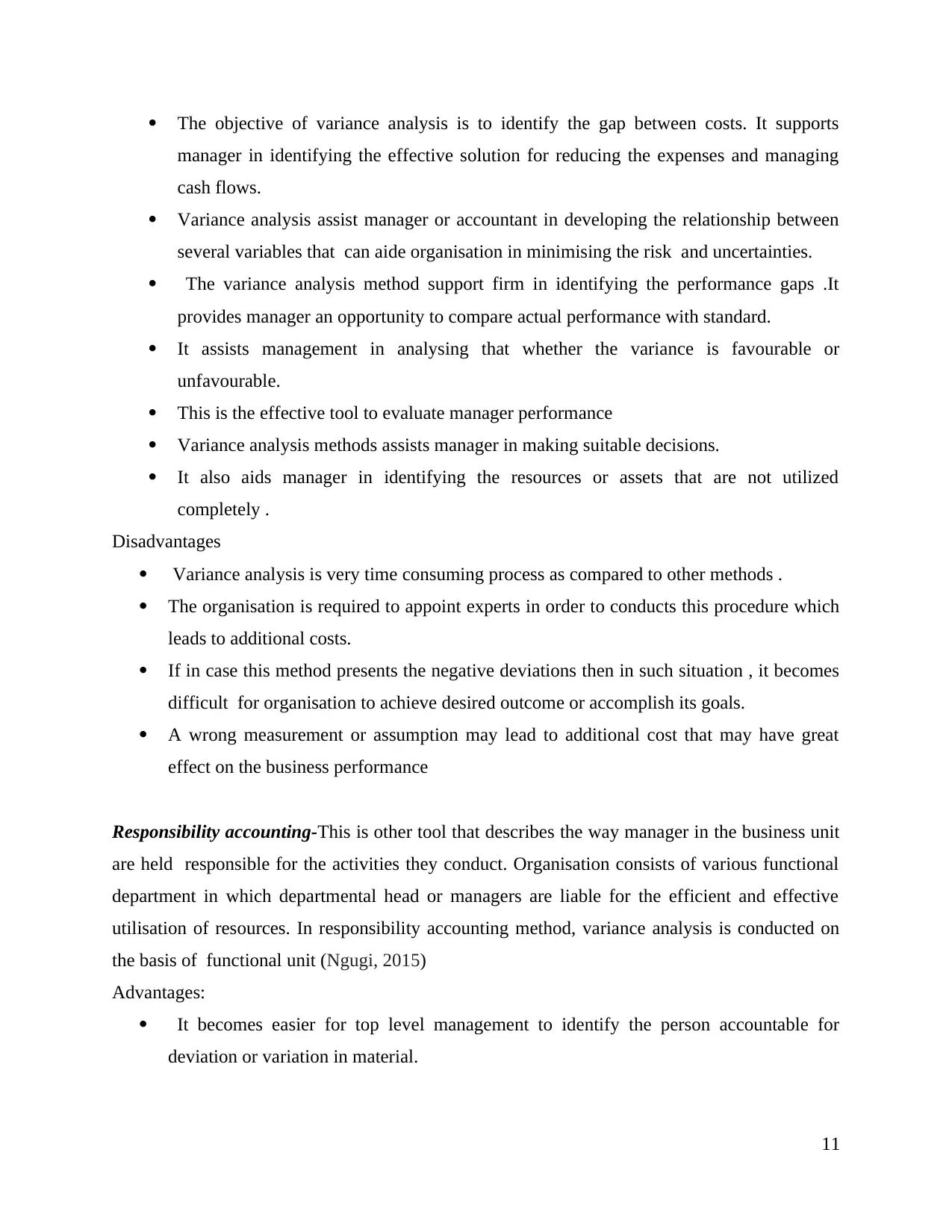
The objective of variance analysis is to identify the gap between costs. It supports
manager in identifying the effective solution for reducing the expenses and managing
cash flows.
Variance analysis assist manager or accountant in developing the relationship between
several variables that can aide organisation in minimising the risk and uncertainties.
The variance analysis method support firm in identifying the performance gaps .It
provides manager an opportunity to compare actual performance with standard.
It assists management in analysing that whether the variance is favourable or
unfavourable.
This is the effective tool to evaluate manager performance
Variance analysis methods assists manager in making suitable decisions.
It also aids manager in identifying the resources or assets that are not utilized
completely .
Disadvantages
Variance analysis is very time consuming process as compared to other methods .
The organisation is required to appoint experts in order to conducts this procedure which
leads to additional costs.
If in case this method presents the negative deviations then in such situation , it becomes
difficult for organisation to achieve desired outcome or accomplish its goals.
A wrong measurement or assumption may lead to additional cost that may have great
effect on the business performance
Responsibility accounting-This is other tool that describes the way manager in the business unit
are held responsible for the activities they conduct. Organisation consists of various functional
department in which departmental head or managers are liable for the efficient and effective
utilisation of resources. In responsibility accounting method, variance analysis is conducted on
the basis of functional unit (Ngugi, 2015)
Advantages:
It becomes easier for top level management to identify the person accountable for
deviation or variation in material.
11
manager in identifying the effective solution for reducing the expenses and managing
cash flows.
Variance analysis assist manager or accountant in developing the relationship between
several variables that can aide organisation in minimising the risk and uncertainties.
The variance analysis method support firm in identifying the performance gaps .It
provides manager an opportunity to compare actual performance with standard.
It assists management in analysing that whether the variance is favourable or
unfavourable.
This is the effective tool to evaluate manager performance
Variance analysis methods assists manager in making suitable decisions.
It also aids manager in identifying the resources or assets that are not utilized
completely .
Disadvantages
Variance analysis is very time consuming process as compared to other methods .
The organisation is required to appoint experts in order to conducts this procedure which
leads to additional costs.
If in case this method presents the negative deviations then in such situation , it becomes
difficult for organisation to achieve desired outcome or accomplish its goals.
A wrong measurement or assumption may lead to additional cost that may have great
effect on the business performance
Responsibility accounting-This is other tool that describes the way manager in the business unit
are held responsible for the activities they conduct. Organisation consists of various functional
department in which departmental head or managers are liable for the efficient and effective
utilisation of resources. In responsibility accounting method, variance analysis is conducted on
the basis of functional unit (Ngugi, 2015)
Advantages:
It becomes easier for top level management to identify the person accountable for
deviation or variation in material.
11
⊘ This is a preview!⊘
Do you want full access?
Subscribe today to unlock all pages.

Trusted by 1+ million students worldwide
1 out of 18
Related Documents
Your All-in-One AI-Powered Toolkit for Academic Success.
+13062052269
info@desklib.com
Available 24*7 on WhatsApp / Email
![[object Object]](/_next/static/media/star-bottom.7253800d.svg)
Unlock your academic potential
Copyright © 2020–2025 A2Z Services. All Rights Reserved. Developed and managed by ZUCOL.





